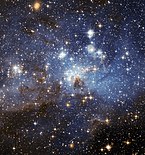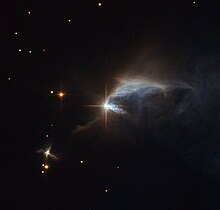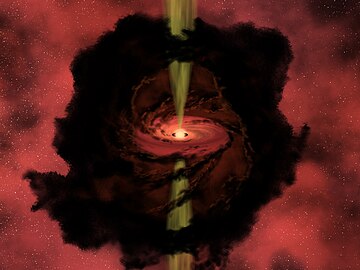Protostar
| Star formation |
|---|
 |
| Object classes |
| Theoretical concepts |
A protostar is a very young
History
The modern picture of protostars, summarized above, was first suggested by Chushiro Hayashi in 1966.[3] In the first models, the size of protostars was greatly overestimated. Subsequent numerical calculations[4][5][6] clarified the issue, and showed that protostars are only modestly larger than main-sequence stars of the same mass. This basic theoretical result has been confirmed by observations, which find that the largest pre-main-sequence stars are also of modest size.
Protostellar evolution

Star formation begins in relatively small

The gas that collapses toward the center of the dense core first builds up a low-mass protostar, and then a protoplanetary disk orbiting the object. As the collapse continues, an increasing amount of gas impacts the disk rather than the star, a consequence of angular momentum conservation. Exactly how material in the disk spirals inward onto the protostar is not yet understood, despite a great deal of theoretical effort. This problem is illustrative of the larger issue of accretion disk theory, which plays a role in much of astrophysics.

Regardless of the details, the outer surface of a protostar consists at least partially of shocked gas that has fallen from the inner edge of the disk. The surface is thus very different from the relatively quiescent
The energy generated from ordinary stars comes from the nuclear fusion occurring at their centers. Protostars also generate energy, but it comes from the radiation liberated at the shocks on its surface and on the surface of its surrounding disk. The radiation thus created must traverse the
The actual radiation emanating from a protostar is predicted to be in the infrared and millimeter regimes. Point-like sources of such long-wavelength radiation are commonly seen in regions that are obscured by molecular clouds. It is commonly believed that those conventionally labeled as Class 0 or Class I sources are protostars.[13][14] However, there is still no definitive evidence for this identification.
Observed classes of young stars
| Class | peak emission | duration (years) |
|---|---|---|
| 0 | submillimeter | 104 |
| I | far-infrared | 105 |
| II | near-infrared | 106 |
| III | visible | 107[15] |
Gallery
-
Video about the protostar V1647 Orionis and its X-ray emission (2004).
-
Protostar outburst - HOPS 383 (2015).
-
Protostar in Herbig-Haro 46/47.
-
A protostar inside a Bok globule (Artist's image).
-
Stellar cluster RCW 38, around the young star IRS2, a system of two massive stars and protostars.
-
Structures of dust forming around a protostar (in the central pink line) in nebula L1527 (2022).
See also
- Stellar birthline
- Pre-main-sequence star
- Protoplanetary disk
- Quasi-star
- Star formation
- Stellar evolution
References
- ISBN 3-527-40559-3.
- S2CID 89604015.
- .
- .
- doi:10.1086/157734.
- doi:10.1086/158377.)
{{cite journal}}: CS1 maint: multiple names: authors list (link - ^ "Infant Star's First Steps". Retrieved 10 November 2015.
- doi:10.1086/160780.
- doi:10.1086/155274.
- S2CID 16270619.)
{{cite journal}}: CS1 maint: multiple names: authors list (link - ^ "A diamond in the dust". Retrieved 16 February 2016.
- doi:10.1086/166694.
- hdl:2060/19870005633.)
{{cite journal}}: CS1 maint: multiple names: authors list (link - doi:10.1086/172425.)
{{cite journal}}: CS1 maint: multiple names: authors list (link - ^ "IMPRS" (PDF). www.solar-system-school.de.
External links
- Planet-Forming Disks Might Put Brakes On Stars (SpaceDaily) July 25, 2006
- Planets could put the brakes on young stars Lucy Sherriff (The Register) Thursday 27 July 2006 13:02 GMT
- Why Fast-Spinning Young Stars Don't Fly Apart (SPACE.com) 24 July 2006 03:10 pm ET
- Webb reveals protostar features within the dark cloud L1527 (jameswebbdiscovery.com) 16 November 2022 11:00 am ET





